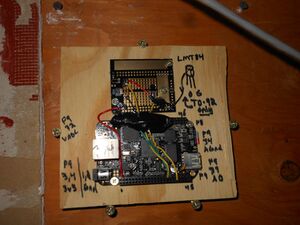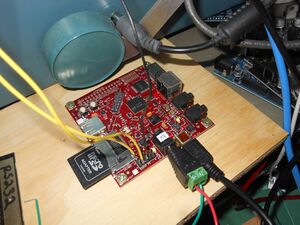Difference between revisions of "Beaglebone"
| Line 173: | Line 173: | ||
Adjust the font size of the local svideo tty with dpkg-reconfigure console-font. Review the different fonts as they have different max sizes. Some are easier to read than others. | Adjust the font size of the local svideo tty with dpkg-reconfigure console-font. Review the different fonts as they have different max sizes. Some are easier to read than others. | ||
| + | |||
| + | ==See also== | ||
| + | * [[MCP3021]] - I2C example w/beaglebone. | ||
==External Links== | ==External Links== | ||
Revision as of 22:47, 30 June 2020
The beaglebone is similar to the RPI, but more powerful for microcontroller applications. There are more accessible GPIO and peripherals.
PocketBeagle
Connected via usb. Opens up cloud9 IDE, and gives you a web server connected arduino like interface to program the AM355x CPU.
Connecting to Beagle from host via usb
ip link ip link set en2923492024 up (whatever the interface was renamed to - see dmesg) dhclient en2923492024 ssh debian@192.168.6.2 (or 7.2)
See troubleshooting note about ipv4 not working below.
Here's a script I use on my beaglebone to connect to a beagleboard (similar when connected via usb)(this contains some of the steps mentioned below regarding internet sharing)
Contents of /root/usb19216871.sh
GNU\Linux Sharing internet with Pocketbeagle over USB
Had some trouble with this today. This guide: https://elementztechblog.wordpress.com/2014/12/22/sharing-internet-using-network-over-usb-in-beaglebone-black/ does NOT work. These guides are also no good: https://unix.stackexchange.com/questions/520528/sharing-internet-using-network-over-usb-in-raspberry-zero-based-on-beaglebone These steps are partially covered in the official beagle directory here: /opt/scripts/network/doc-debian-setup.md
You don't need to setup a bridge. It might work that way, but its not required. What works is the following:
- (pocketbeagle) Add route w/host ip
- (host) enable packet forwarding
- (host) NAT forwarding
- (pocketbeagle) DNS - resolv.conf
On beagle
Have Pocketbeagle Route to Host
# route add default gw 192.168.6.1
Or 192.168.7.1, see # route
On Host
Enable packet forwarding on Host
Check the current packet forwarding settings:
# sysctl -a | grep forward
You will note that options exist for controlling forwarding per default, per interface, as well as separate options for IPv4/IPv6 per interface.
Enter this command to temporarily enable packet forwarding at runtime:
# sysctl net.ipv4.ip_forward=1
Edit /etc/sysctl.d/30-ipforward.conf to make the previous change persistent after a reboot for all interfaces:
/etc/sysctl.d/30-ipforward.conf
net.ipv4.ip_forward=1
Afterwards it is advisable to double-check forwarding is enabled as required after a reboot. Enable NAT on Host With iptables
# iptables -t nat -A POSTROUTING -o eth0 -j MASQUERADE # iptables -A FORWARD -m conntrack --ctstate RELATED,ESTABLISHED -j ACCEPT # iptables -A FORWARD -i usb0 -o eth0 -j ACCEPT
ref: https://wiki.archlinux.org/index.php/Internet_Sharing
Fix DNS on beagle
At this point, you will have ip routing, but DNS isn't setup yet. To get DNS working put your preferred name server in /etc/resolv.conf
nameserver 192.168.1.1
Note: If you are testing an existing ping, when you change the iptables settings, you must stop / start a new ping to see the changes take effect. Note: It's nameserver ###.###.###.###, not just the #.
Question: Why isn't /etc/resolv.conf called /etc/nameserver ? How about a symbolic link? Is that too obvious?
IPv4 usb Interface Not Working
Had ipv4 not working for pocketbeagle today. Same image, same computer... Throw it out the window.
dhclient of usb interface on host gave only ipv6 address. ssh was able to connect via beagle's ipv6 address (ipv6%interface, e.g. ssh debian@fe80%usb1)
the two virtual usb ethernet interfaces that show up in host are always 192.168.7 or 192.168.6 range. Try one, if you can't ping the beagle at 192.168.6.2 (it's always 2) then try the 7 range. (on host)
ifconfig en238240224 192.168.6.1 ping 192.168.6.2
Sysvinit on pocketbeagle
(Via Devuan): Breaks ssh usb access. Only use if you have a wifi/ethernet adapter connected and ip info set in /etc/network/interfaces, or UART connected.
May have to edit inittab to add (correct) serial. See beagleboard section.
Alpine on pocketbeagle
This script doesn't compile on Debian (Devuan) Stretch (kernel phase. uboot compiles). GCC appears to be the wrong version. GCC 5 has been removed from Debian stretch repos. https://github.com/BrianSidebotham/alpine-on-bbb
Change Partition Size on SD
https://elinux.org/Beagleboard:Expanding_File_System_Partition_On_A_microSD
Beaglebone Black
Always Boot from SD Card
"...move R68 to R93 if you want to make the board boot from SD by default."
ref: https://stackoverflow.com/questions/33030802/fix-the-boot-order-emmc-on-a-beagle-bone-black
A latching switch would be nice. Onboard flash is built in obsolescence.
Instructions
Put some leaded solder on both sides of R68 (bottom of board, the silkscreen is misplaced, but just count down the line). Use hot air to remove R68, being careful not to use too much air flow which will knock the resistor off your bench, onto the floor. The resistor is a 100K, in case you lose it.
After removing the resistor, use an iron to put small dobs of leaded solder on pad R93 (top side of board). Use hot air to heat the board until the solder is fluid, then place the 100K R onto R93, heating as necessary while being careful not to blow the resistor away.
Beagleboard
The beagleboard is the original. It has more connectors / peripherals, however lacks ethernet.
Resources for beagleboard:
- https://elinux.org/BeagleBoard_Community#Board_recovery
- https://elinux.org/BeagleBoardRecovery
- https://elinux.org/BeagleBoardFAQ
- https://elinux.org/2010_ICASSP_Lab_2_The_Boot_Sequence
RS232 Serial is garbled and unreadable
Yes, I said RS232. This is not TTL levels. You need -12 and +12V, so use a RS232 port.
I resolved an issue of garbled serial by using an external 5V 3A PSU, and also by locating the laptop PSU adjacent to the BB PSU on mains via a power strip. Laptop USB did not work, nor did a 1A 0-12V adjustable PSU, as they were not close enough on the mains (different outlets)
I also had a poorly made thinkpad dock that required a 'hard' shutdown in order for rs232 to restart, after gnu screen was closed/reopened.
OS for original Beagleboard
Angstrom loads on the old uboot without problem. Debian Buster Console (link: https://elinux.org/Beagleboard:BeagleBoneBlack_Debian#Debian_Buster_Console_Snapshot_for_BeagleBoard-xM tested: bbxm-debian-10.4-console-xm-armhf-2020-05-18-1gb.img.xz) also loads, though requires holding user button upon boot (forces boot from mmc) due to uboot being ancient on the nand.
- Other OS: openwrt
Angstrom: Tweaks to make
It boots up in systemd X11 session, which is using 60MB of RAM. First thing to do is disable X11. This uses an older systemd syntax, so it is something like
systemctl -h systemctl list-unit-files systemctl disable graphical.target systemctl enable multi-user.target
This will lower it to 30MB of RAM.
Debian Buster Console
Don't mess with Angstrom, use this instead. Link is buried and hard to find, but see: https://elinux.org/Beagleboard:BeagleBoneBlack_Debian#Debian_Buster_Console_Snapshot_for_BeagleBoard-xM
Upgrading old UBoot for new Debian Images
WIP
Migrate to Devuan / Sysvinit
Requires modprobe g_ether (usb gagdet for ethernet) to /etc/modules Requires adding serial to /etc/inittab Make it easier by using usb to ethernet adapter (or wifi).
always boot usb0
When migrating to devuan you need modprobe g_ether in /etc/modules or modprobe.conf (forget which).
in /etc/rc.local add
ip link set usb0 up
in /etc/network/interfaces add
auto usb0
iface usb0 inet static
address 192.168.7.2
netmask 255.255.255.0
gateway 192.168.7.1
note that the official bbb images have a netmask of 255.255.255.252 for these usb interfaces, but I will ignore that. They also use scripts e.g. /opt/scripts/boot/autoconfigure_usb0.sh which are messier than above.
S-video output
The SVideo output is Luminance/Sync (Y) and Chroma(C). You can turn this into composite, and then output to a CRT.
Adjust the font size of the local svideo tty with dpkg-reconfigure console-font. Review the different fonts as they have different max sizes. Some are easier to read than others.
See also
- MCP3021 - I2C example w/beaglebone.
External Links
- https://github.com/mvduin/bbb-pin-utils/#show-pins Easily Display Information about pins.
- https://elinux.org/ - General Information
| ||||||||||||||||||

